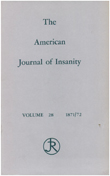Correlates of accuracy in the assessment of psychiatric inpatients' risk of violence
Abstract
OBJECTIVE: The authors evaluated characteristics of patients whom clinicians accurately assessed as being at high or low risk for violence and patients for whom clinicians overestimated or underestimated the risk. METHOD: At admission, physicians estimated the probability that each of 226 psychiatric inpatients would physically attack someone during the first week of hospitalization. Nurses rated assaultive behavior in the hospital with the Overt Aggression Scale. Acute symptoms were rated with the Brief Psychiatric Rating Scale. RESULTS: For the group as a whole, assessed levels of risk were substantially related to later physical aggression (sensitivity = 67%, specificity = 69%). Multinomial logit analysis showed that patients with psychotic disorders such as schizophrenia, organic psychotic conditions, and mania were more likely to be accurately assessed by clinicians as being at high risk (true positives) than to be true negatives or false positives. A recent history of violence was associated with higher estimated risk but did not distinguish true positives from false positives. An admission mental status characterized by low levels of hostility, uncooperativeness, and suspiciousness and high levels of depression, guilt, and anxiety differentiated true negative patients from others, but symptom profiles did not differ among true positives, false positives, and false negatives. Clinical judgments emphasizing gender and race/ethnicity were associated with predictive errors: nonwhite and male patients tended to be false positives. CONCLUSIONS: While clinicians can accurately classify the potential for violence in the majority of patients at admission, systematic errors characterize inaccurate assessments of the risk. Awareness of these patterns may help improve assessment of the risk of violence in clinical practice.
Access content
To read the fulltext, please use one of the options below to sign in or purchase access.- Personal login
- Institutional Login
- Sign in via OpenAthens
- Register for access
-
Please login/register if you wish to pair your device and check access availability.
Not a subscriber?
PsychiatryOnline subscription options offer access to the DSM-5 library, books, journals, CME, and patient resources. This all-in-one virtual library provides psychiatrists and mental health professionals with key resources for diagnosis, treatment, research, and professional development.
Need more help? PsychiatryOnline Customer Service may be reached by emailing [email protected] or by calling 800-368-5777 (in the U.S.) or 703-907-7322 (outside the U.S.).



